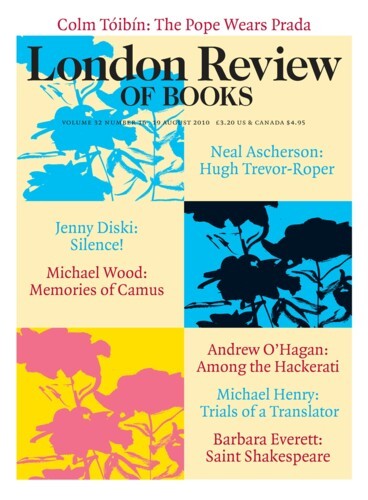French law requires that a purebred dog or cat – that is, an animal belonging to one of the breeds listed in the Livre des origines français or the Livre officiel des origins felines – be given a name beginning with a prescribed letter of the alphabet, determined by the year of its birth, rather like the way British car registration plates used to be organised.
Gillian Darley
Gillian Darley is an architectural historian whose books include Excellent Essex and biographies of Sir John Soane, John Evelyn and Octavia Hill, the founder of the National Trust.
The modernist mantra that form follows function is best suited to industrial buildings. Even the great cooling towers of coal-fired power stations, visible for miles around like the funnels of land-locked ocean liners, can be celebrated as functional architecture. But the inscrutable form of the nuclear power plant gives nothing away. The events at Fukushima are a terrifying reminder of what those innocuous-looking boxes actually contain.
When I was a student I lived over a shop, just off the Edgware Road. Four of us squeezed in, and the cobbler and his wife (no, this wasn’t the 19th century) kept a kindly eye on us before heading home in the evenings to Purley. These days, as I wander the high streets of towns, small, medium and large, with an eye cast upwards, alert to any signs of life, I rarely see anything more than mountains of cardboard boxes or clothes racks. A campaign, LOTS (Living Over the Shops), which might have been a lot shriller, for years tried to draw attention to this wasted space, accommodation that doesn’t appear in the national estimates of empty housing – written out in favour of ‘guesstimates’ of the soaring need for more housing ‘units’, especially in the south-east.
My Cat All My Pleasure: Georgian Life
Gillian Darley, 19 August 2010
Cut-paper work from 1707 by the 17-year-old Anna Maria Garthwaite, who later became a designer of patterned silks for dresses
In contrast to the still contentment of a Zoffany conversation piece or the energetic racket conjured up by Fielding’s novels, life indoors in Georgian England was frequently a dull, hard and miserable business. For those who did not fit the norms, social or...
Even though I was born almost in Essex, giving me an enduring taste for the exceptional qualities of an unexceptional landscape which I often indulge by walking in it, I hadn’t read (or, frankly, even heard of) J.A. Baker’s The Peregrine until it was reissued by New York Review Books a few years ago. Robert Macfarlane’s introduction says that almost nothing is known about Baker except that he was born in 1926 and was diagnosed with a serious illness around the time the book was published in 1967. The NYRB blurb added that ‘he appears to have worked as a librarian for the remainder of his life.’ There was no date of death. The book is written in the form of a journal over six months, from October to April. Criss-crossing on his bicycle a small area of countryside to the east of Chelmsford, Baker is on the track of a peregrine falcon – less murderous in intent than Captain Ahab, but no less obsessed.
Pieces about Gillian Darley in the LRB
Half-Wrecked: What’s left of John Soane
Mary Beard, 17 February 2000
It is hard to resist the conclusion that Soane’s central place in architectural mythology is connected to the fact that he can be ‘reinvented’ more freely than those architects whose buildings do...
Read anywhere with the London Review of Books app, available now from the App Store for Apple devices, Google Play for Android devices and Amazon for your Kindle Fire.
Sign up to our newsletter
For highlights from the latest issue, our archive and the blog, as well as news, events and exclusive promotions.


